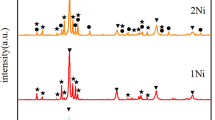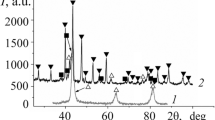Abstract
A series of multi-principal-element (MPE) alloys have been prepared by adding Ni, Mn, Al, Cu and Y into the reference CoCrFe-B alloy. The microstructure and mechanical properties of these MPE alloys have been investigated thoroughly. It is found that the addition of the elements can inhibit boride precipitation in the designed alloys and the solid solution strengthening effect induced by interstitial boron atoms is more significant than that by boride precipitation. The MPE alloys with the fcc phase as the main solid solution phase have a higher boron solubility and hence less boride precipitation, than those with the bcc phase as the main solid solution phase. The addition of yttrium can improve the boron solubility, decrease boride precipitation, control the boride morphology and, importantly, simultaneously improve the compressive strength and ductility of boron-containing MPE alloys.





Similar content being viewed by others
References
J.W. Yeh, S.K. Chen, S.J. Lin, J.Y. Gan, T.S. Chin, T.T. Shun, C.H. Tsau, and S.Y. Chang, Nanostructured High-Entropy Alloys with Multiple Principal Elements: Novel Alloy Design Concepts and Outcomes, Adv. Eng. Mater., 2004, 6, p 299–303
Y. Zhang, T.T. Zuo, Z. Tang, M.C. Gao, K.A. Dahmen, P.K. Liaw, and Z.P. Lu, Microstructures and Properties of High-Entropy Alloys, Prog. Mater Sci., 2014, 61, p 1–93
B. Gludovatz, A. Hohenwarter, D. Catoor, E.H. Chang, E.P. George, and R.O. Ritchie, A Fracture-Resistant High-Entropy Alloy for Cryogenic Applications, Science, 2014, 345, p 1153–1158
H. Zhang, Y.Z. He, Y. Pan, and S. Guo, Thermally Stable Laser Cladded CoCrCuFeNi high-Entropy Alloy Coating with Low Stacking Fault Energy, J. Alloys Compd., 2014, 600, p 210–214
N. Yu, N.D. Yurchenko, D.G. Stepanov, M.A. Shaysultanov, G.A. Tikhonovsky, and S. Salishchev, Effect of Al Content on Structure and Mechanical Properties of the Al x CrNbTiVZr (x = 0, 0.25, 0.5, 1) High-Entropy Alloys, Mater. Charact., 2016, 121, p 125–134
T.F. Yang, S.Q. Xia, S. Liu, C.X. Wang, S.S. Liu, Y. Zhang, J.M. Xue, S. Yan, and Y.G. Wang, Effects of Al Addition on Microstructure and Mechanical Properties of AlxCoCrFeNi High-Entropy Alloy, Mater. Sci. Eng. A, 2015, 648, p 15–22
M.H. Chuang, M.H. Tsai, W.R. Wang, S.J. Lin, and J.W. Yeh, Microstructure and Wear Behavior of Al x Co1.5CrFeNi1.5Ti y High-Entropy Alloys, Acta Mater., 2011, 59, p 6308–6317
G.J. Chen, C. Zhang, and Q.H. Tang, Effect of Boron Addition on the Microstructure and Wear Resistance of FeCoCrNiB x (x = 0.5, 0.75, 1.0, 1.25) High-Entropy Alloy Coating Prepared by Laser Cladding, Rare Metal Mater. Eng., 2015, 44, p 1418–1422
C.P. Lee, Y.Y. Chen, and C.Y. Hsu, The Effect of Boron on the Corrosion Resistance of the High Entropy Alloys Al0.5CoCrCuFeNiB x , J. Electrochem. Soc., 2007, 154, p 424–430
N.D. Stepanov, N.Y. Yurchenko, M.A. Tikhonovsky, and G.A. Salishchev, Effect of Carbon Content and Annealing on Structure and Hardness of the CoCrFeNiMn-Based High Entropy Alloys, J. Alloys Compd., 2016, 687, p 59–71
G.H. Meng, X. Lin, H. Xie, T.M. Yue, X. Ding, L. Sun, and M. Qi, The Effect of Cu Rejection in Laser Forming of AlCoCrCuFeNi/Mg Composite Coating, Mater. Des., 2016, 108, p 157–167
H. Zhang, Y. Pan, and Y.Z. He, Synthesis and Characterization of FeCoNiCrCu High-Entropy Alloy Coating by Laser Cladding, Mater. Des., 2011, 32, p 1910–1915
N. Aleksandra, A. Merati, B. Mariusz, B. Manon, F. Olaniyi, and N. Michel, Instrumented and Vickers Indentation for the Characterization of Stiffness, Hardness and Toughness of Zirconia Toughened Al2O3 and SiC Armor, J. Mater. Sci. Technol., 2015, 31, p 773–783
C. Zhang, G.J. Chen, and P.Q. Dai, Evolution of the Microstructure and Properties of Laser-Clad FeCrNiCoB x High-Entropy Alloy Coatings, Mater. Sci. Technol., 2016, 32, p 1666
X. Yu, Z.H. Zhang, and J.X. Xie, Effects of Rare Earth Elements Doping on Ordered Structures and Ductility Improvement of Fe-6.5 wt.%Si Alloy, Mater. Lett., 2016, 184, p 294–297
M. Suhrit, S. Daria, Y. Khaled, R.O. Scattergood, and C.K. Carl, Structural Evolution of Cu(1−x)Y x Alloys Prepared by Mechanical Alloying: Their Thermal Stability and Mechanical Properties, J. Alloys Compd., 2015, 627, p 108–116
Acknowledgments
The authors thank the financial support from the National Natural Science Foundation of China (NSFC) under Grant No. 51271001 and Joint Fund of Iron and Steel Research by NSFC under Grant No. U1560105, the University Natural Science Research Project of Anhui Province of China under Grant No. KJ2014A029 and the Tribology Science Fund of State Key Laboratory of Tribology under Grant No. SKLTKF14B02.
Author information
Authors and Affiliations
Corresponding author
Rights and permissions
About this article
Cite this article
Zhang, H., Zhong, X.C., He, Y.Z. et al. Effect of High Configuration Entropy and Rare Earth Addition on Boride Precipitation and Mechanical Properties of Multi-principal-Element Alloys. J. of Materi Eng and Perform 26, 3750–3755 (2017). https://doi.org/10.1007/s11665-017-2831-3
Received:
Revised:
Published:
Issue Date:
DOI: https://doi.org/10.1007/s11665-017-2831-3




